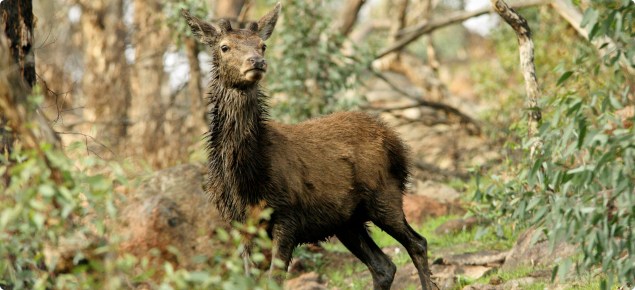Identification
|
| Rusa | Red | Fallow |
| Species name | Cervus timorensis | Cervus elaphus | Dama dama |
| Status | Declared pest C1 | Declared pest C3 | Declared pest C3 |
| Permit to keep | Prohibited under the Biosecurity and Agriculture Management Act 2007. | Permitted under the Biosecurity and Agriculture Management Regulations 2013 for farming, zoological displays and educational purposes. | Permitted under the Biosecurity and Agriculture Management Regulations 2013 for farming, zoological displays and educational purposes. |
| Native to Australia | No | No | No |
| Male | 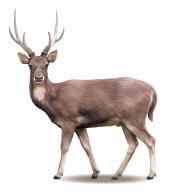 Male rusa stag Weight: 80 to 140 kg Height: Up to 110 cm Develop a dark, heavy mane. Lyre-shaped, 3-pointed antlers. The rear tine is the longest. | 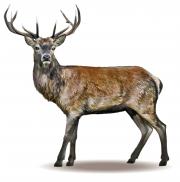 Red male stag Weight: 135 to 160 kg Height: Up to 120 cm Multi-pointed antlers that have 6 to 8 points. Antlers are cast between October and November and reformed by February. | 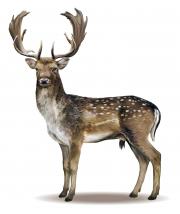 Fallow male stag Weight: 50 to 100 kg Height: Up to 95 cm Multi-pointed, palm-like antlers. Antlers are cast in October and reformed by February. |
| Female | Rusa female doe Weight: 50 to 75 kg Height: up to 95 cm | 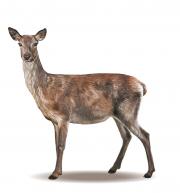 Red female doe Weight: 65 to 100 kg Height: up to 90 cm | 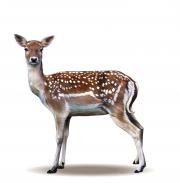 Fallow female doe Weight: 35 to 55 kg Height: up to 80 cm |
| Coat | Summer coat is sparse and
Fawns do not have spots and are reddish-tan in colour with white underparts. | Summer coat is reddish with a distinctive light-coloured patch on the rump. In winter, the coat is slightly greyish-brown in colour.
Fawns often have white spots that fade as they mature. | Highly variable in colour including red, black, white and menil (spotted).
Heart shaped pale rump patch with black outline and a long tail.
|
| Habits | Rusa deer are herbivores that graze a wide range of grasses, shrubs and trees.
They often form large groups. | Red deer are found in open forest and woodlands with grassy understoreys. They often feed in pastures and crops. Red deer often form large groups. | Fallow inhabit semi-open scrubland, grazing graze on pasture that is near cover. |
| Breeding | Mate between June and August. Fawns are born between March and April.
Male rusa deer often decorate their antlers with twigs and grass during the breeding season.
They can hybridise with red deer, but only produce fertile female offspring. | Mate from March to April. Fawns are born in December.
Males are only territorial during mating season and roar to attract receptive females. | Mate from April to May Fawns are born in December. Bucks make an unmistakable croak, like a grunting pig.
Calls vary from high pitched bleating to deep grunts.
|
Damage
Feral deer costs tens of millions of dollars each year through agricultural losses (grazing industries), and expenditure on management and research.
The impacts of feral deer increase as their density increases, meaning that proactive control is the most effective method of avoiding the damage they cause. Feral deer can:
- change the natural landscape by grazing and browsing plants
- compete with native fauna for food and habitat resources
- damage to pasture, commercial crops, orchards and infrastructure
- compete with livestock
- impacts water quality, soil properties and nutrient cycling (Davis et al. 2016).
- act as vectors for disease and pathogens, including foot-and-mouth disease.
They can also transmit exotic livestock diseases to cattle, sheep and goats like Trypanasoma evansi which is fatal to dogs, cats and horses.
They are a public health risk, causing motor vehicle accidents, and have been known to carry diseases that can be transmitted to humans, such as leptospirosis and bovine tuberculosis.
Location
Feral deer populations are widespread, but patchy in the south-west of WA:
| Area | Species | Location |
| Northern population | Red and fallow deer | Geraldton, Northampton, Chapman Valley and Greenough areas. |
| South-west population | Red and fallow deer | Agricultural and forested land from Gingin and the Perth Hills, through the Peel, Harvey, Collie, Donnybrook and Margaret River regions, south to Manjimup and Denmark. |
| Rusa deer | Harvey area | |
| South coast population | Red deer | Known to occur in the Esperance area. |
Diet
Feral deer graze and browse on a range of pasture, crop, and native species. They regularly compete with livestock for grazing on farmland. However, many feral deer species stand on hindlegs to browse trees, as well as eating litterfall.
Fallow deer consume more grasses than red deer. Recent analysis has indicated that adult fallow deer can consume 1.85 DSE (dry-sheep equivalent). Red and rusa deer are larger than fallow deer and are likely to consume even more grasses.
Control
It is important to control feral deer to prevent their spread and reduce their impact. Shooting and trapping can be effective control measures, if conducted as part of a coordinated program. For further information about the control options available, see the glovebox guide by CISS.
Declared pest category
The Western Australian Organism List (WAOL) contains information on the area(s) in which this pest is declared and the control and keeping categories to which it has been assigned in Western Australia (WA). Use the links on this page to reach feral deer in WAOL.
 | MyPestGuide® Reporter Pest and Disease Information Service |

